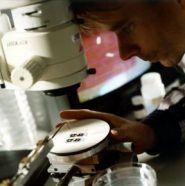Opening a Window on Video Paper
A new type of electronic paper may bring video clips to the daily newspaper.
By Emily Sohn
On school nights, lots of kids have to do their reading before they’re allowed to watch TV. Pretty soon, you might get to do both at the same time, in true Harry Potter style.
Several companies are racing to produce electronic paper and ink, complete with colors and moving images. One idea would be to create a newspaper like The Daily Prophet in the Harry Potter books. Its pages would hold video clips of baseball games, say, instead of just black-and-white photos.
 |
|
A researcher examines small samples of a full-color display that, on a larger scale, might eventually bring video to newspapers and magazines.
|
| Philips |
Electronic paper is not a new idea. A company in Massachusetts called E Ink, for example, has been working for years on a technology that involves millions of tiny liquid-filled spheres, about as wide as a human hair. Jolts of electricity determine whether each microsphere looks black or white at any given time. Together, microspheres make up words and images. The technique seems promising for creating still images that can be changed when needed, but the process is too slow for good video.
Scientists in the Netherlands now report a new type of e-paper technology. By using layers of oil, the researchers say, they can make images that change fast enough to meet standard video requirements. They can also make brilliant colors. So far, however, each image is smaller than the fingernail on your pinkie.
Critics say the new technology requires too much power to be practical. But no one will know if that’s really true until larger screens are made.
For now, reading and watching TV will have to remain two separate activities. Keep your eyes open, though. In the future, TV watching and reading might be part of the same assignment.—E. Sohn
Going Deeper:
Weiss, Peter. 2003. The daily flicks: Morphing ink may bring video to newspapers. Science News 164(Sept. 27):195. Available at http://www.sciencenews.org/20030927/fob1.asp .
You can learn more about electronic paper and ink at http://computer.howstuffworks.com/e-ink.htm (How Stuff Works), http://www.media.mit.edu/micromedia/elecpaper.html (MIT Media Laboratory), and http://www2.parc.com/dhl/projects/gyricon/ (Xerox PARC).







